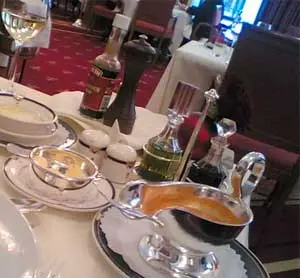 Properly and beautifully presented food not only stimulates the appetite but also aids in digestion. Additionally, an appropriate table setting creates the necessary comfort for enjoying a meal. This is why table service should include all the essential dishes for cold appetizers, first courses, second courses, desserts, hot beverages, pastries, and more.
Properly and beautifully presented food not only stimulates the appetite but also aids in digestion. Additionally, an appropriate table setting creates the necessary comfort for enjoying a meal. This is why table service should include all the essential dishes for cold appetizers, first courses, second courses, desserts, hot beverages, pastries, and more.
Appetizers are served before the first course, with salads (vegetable, meat, fish) placed on the table in salad bowls. A tablespoon is placed on top of the salad, and a plate is set underneath the salad bowl. Herring is served on herring dishes, while caviar is presented in caviar dishes. Green onions accompanying caviar are served on a glass plate. When a caviar dish is unavailable, grainy caviar is served on a glass plate placed in a salad bowl filled with crushed ice. Flat spatulas are provided for serving caviar onto plates. Red caviar, smoked salmon, and salmon are served on small plates, while ham, sausage, boiled fish, baked meats, poultry, and game are served on larger platters. A fork and spoon should be placed on the platters or plates. Various sauces, sour cream, and vinegar with horseradish are served in sauceboats. Butter is served in butter dishes or on a plate. Canned goods in oil are served in their factory boxes on a plate, while those in marinade are served in salad bowls (without the boxes).
When there are many appetizers and not enough space on the table, cold fish appetizers are served first—caviar, lightly salted fish (like salmon, smoked salmon, or trout), herring, canned fish, boiled fish (like sturgeon or beluga), marinated fish, jellied fish, and stuffed fish, as well as carp with honey, among others. Next, cold meat appetizers are served—ham, sausage, suckling pig, pâté, tongue, poultry, game, and aspic. After the meat appetizers, vegetable, meat, or fish salads are presented.
First courses (borscht, cabbage soup, soups, broths) are served after the appetizers in soup bowls with a ladle. Clear broths can also be served in broth cups (holding about 2 cups) with a dessert spoon. Sour cream is served in a sauceboat alongside borscht and cabbage soup, and pastries are provided as well. For clear broths, pastries with appropriate fillings are served, while pureed soups are accompanied by croutons. For okroshka, cold borscht, or cold soup, finely crushed ice can be served in a salad bowl.
Second hot courses are served in a specific order: fish dishes, meat dishes, poultry and game (roasts), vegetables, and greens. The sequence of serving should not be disrupted unless one of the specified dishes is not served. Second courses are presented on platters, with sauces in sauceboats.
Desserts—compotes, fruit jellies, mousses, gelatin, and ice cream—are served in dessert bowls or small vases, filled just before serving. Dessert spoons are provided for sweet dishes, and special spoons are given for ice cream. After dessert, black coffee and fruits can be served during the meal. Black coffee is served in a coffee pot, poured into small cups, and presented on saucers with a small coffee spoon. Fruits are served in deep bowls or pyramid-shaped vases or placed on dessert (appetizer) plates. Instead of black coffee, punch can be served, placed on the table in punch bowls or pitchers. Punch is ladled into punch cups or dessert bowls with a special spoon.
Setting the Table: Dishes, Cutlery, and Food Arrangement
For each diner, a small dinner plate is placed on the table, with an appetizer plate set on top. To the left of the plates, a fork is placed with the tines facing up. If fish dishes are served, a second fork for fish is added. To the left of the forks, a bread plate for rolls and bread is set.
On the right side of the plate, a knife is placed with the blade facing the plate, and next to the knife, a spoon is positioned with the bowl facing up. If fish knives are available, they are placed between the dinner knife and spoon on the right side of the plate.
A napkin is placed on top of the plates. On the appetizer plate, a knife and fork can be placed on top of the napkin. Plates and cutlery should be set about 2 cm from the edge of the table. In the center of the table, large platters with appetizers are arranged, with salad bowls and plates with other appetizers placed at the ends of the table.
Salt, pepper, mustard, and vinegar are set in small containers or separate dishes. To decorate the center of the table, fresh flowers are arranged in tall crystal or porcelain vases.
Setting the Tea Table
For tea, sugar, cakes, cookies, pastries, jam, candies, lemon, and cream are served. Cakes, cookies, and pastries are presented on flat vases. Cakes are cut and served on dessert plates with spatulas, while cookies and pastries are served with tongs.
Jam is served in bowls and spooned into special saucers with a dessert spoon. Candies are presented in bowls or boxes. For unwrapped candies, tongs are placed in the bowls or boxes. Lemon is served on large plates, sliced thinly with the peel on. A special fork is used to take lemon from the plate.
Cream is also served in a cream pitcher. Vases with cakes, cookies, pastries, jam, and candies are arranged in the center of the table. Between them, a sugar bowl, lemon, and cream pitcher are placed. Small stacks of saucers for jam are set in several places. Fruits can also be served in deep bowls at the tea table.
In front of each person seated at the table, a dessert plate with a dessert spoon is placed.
